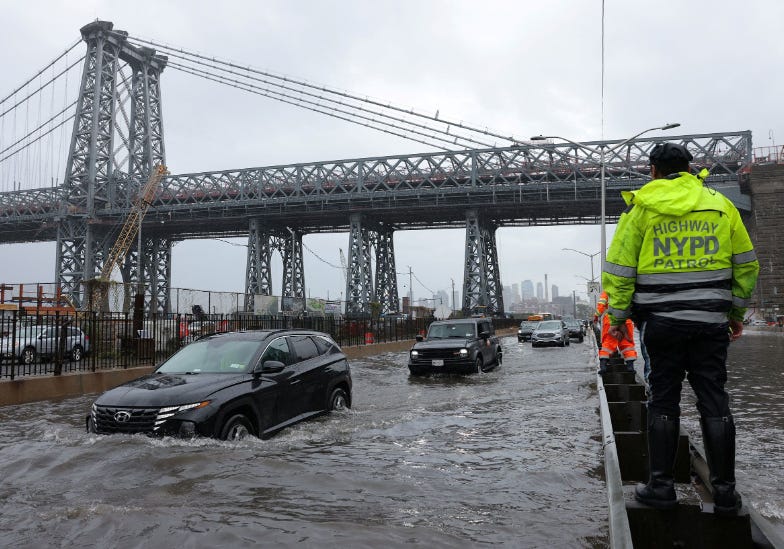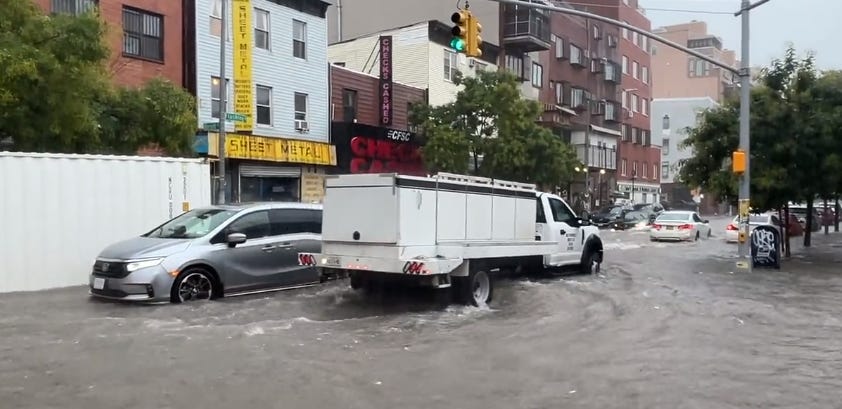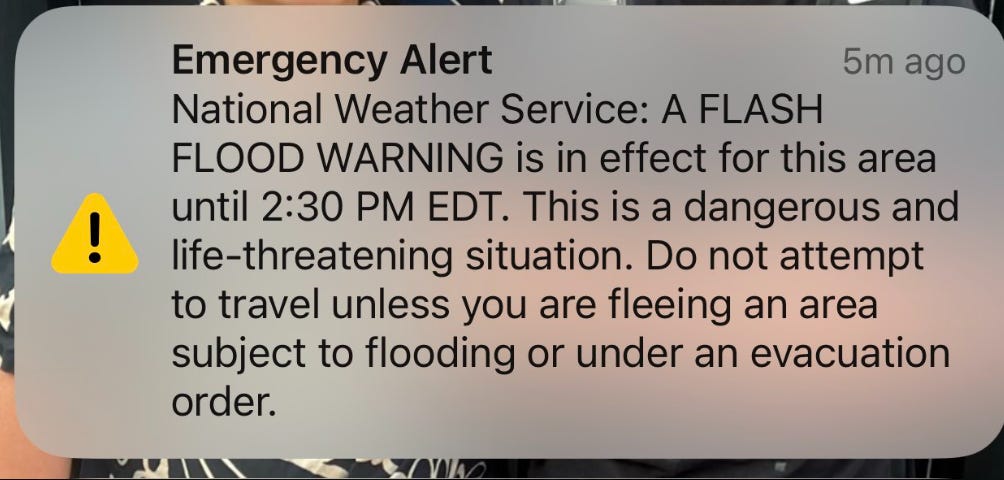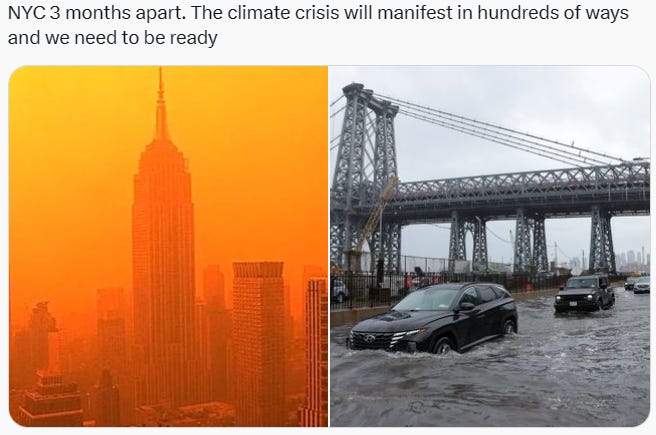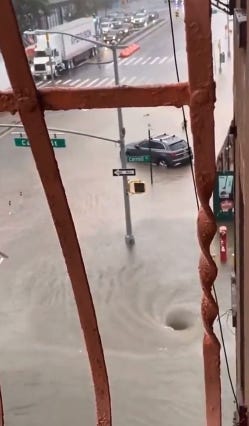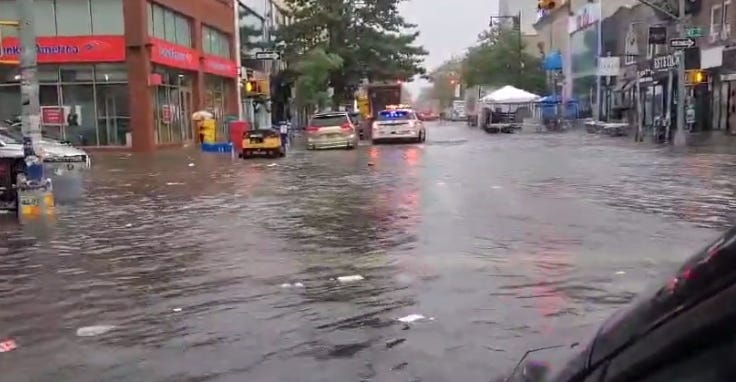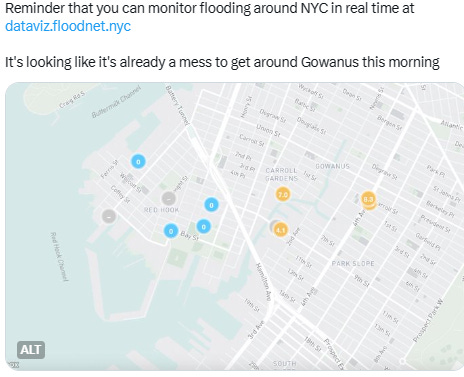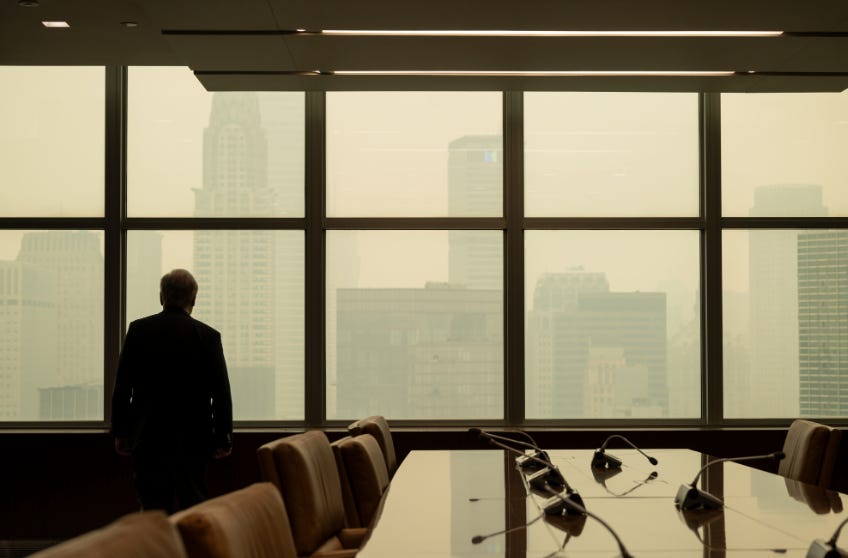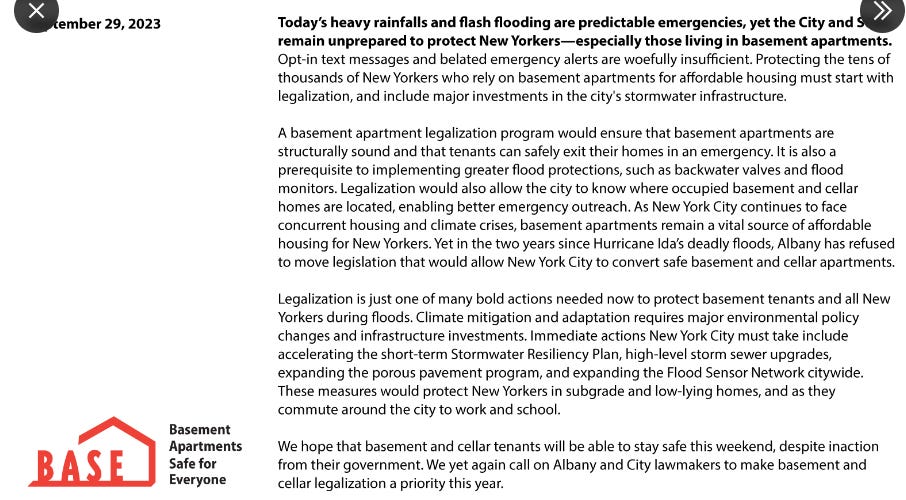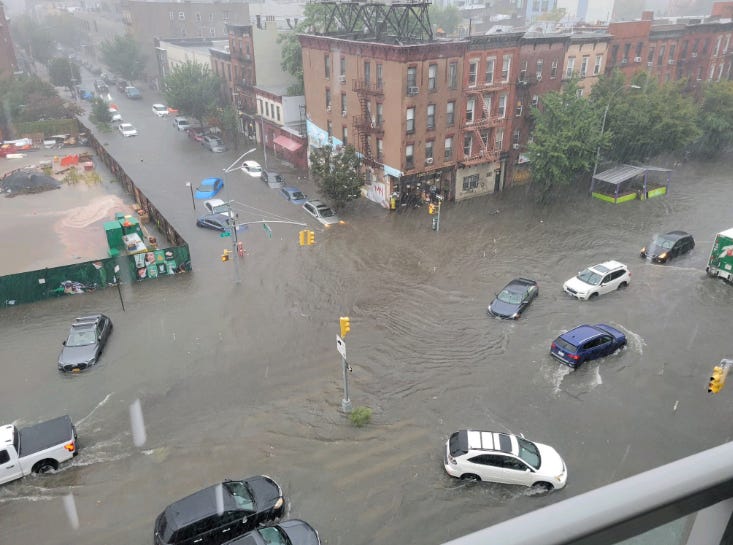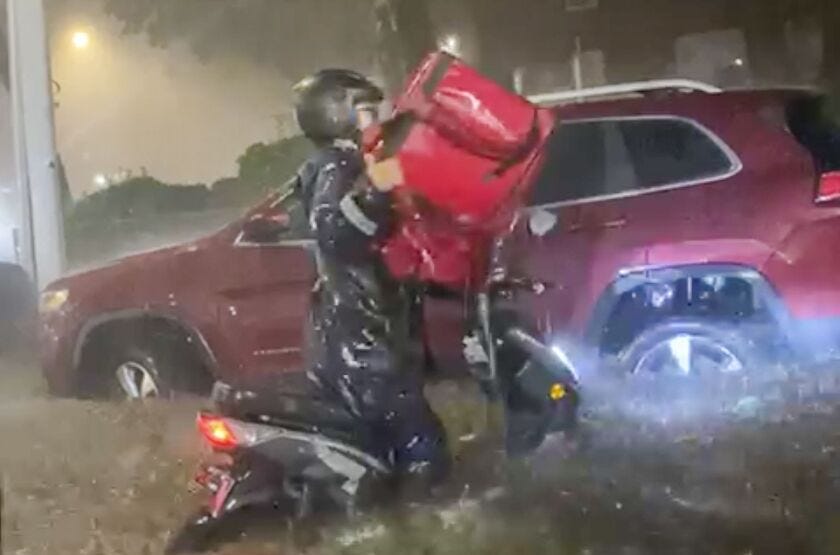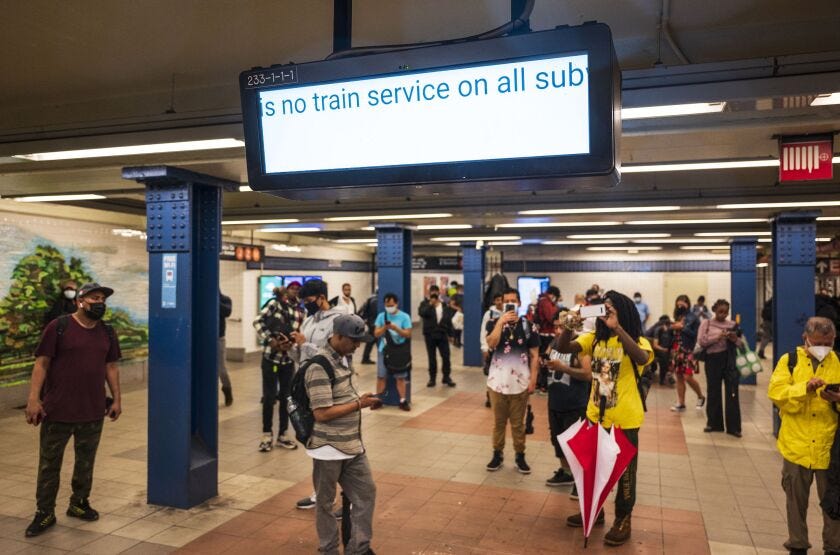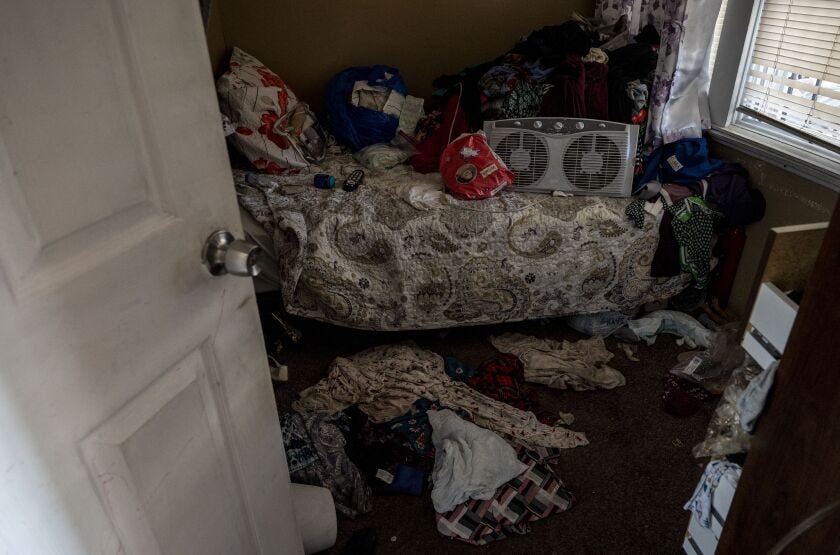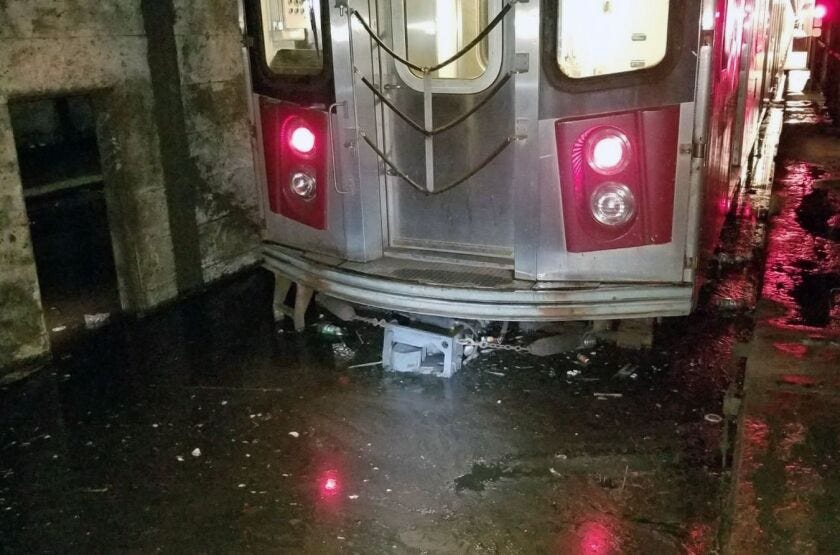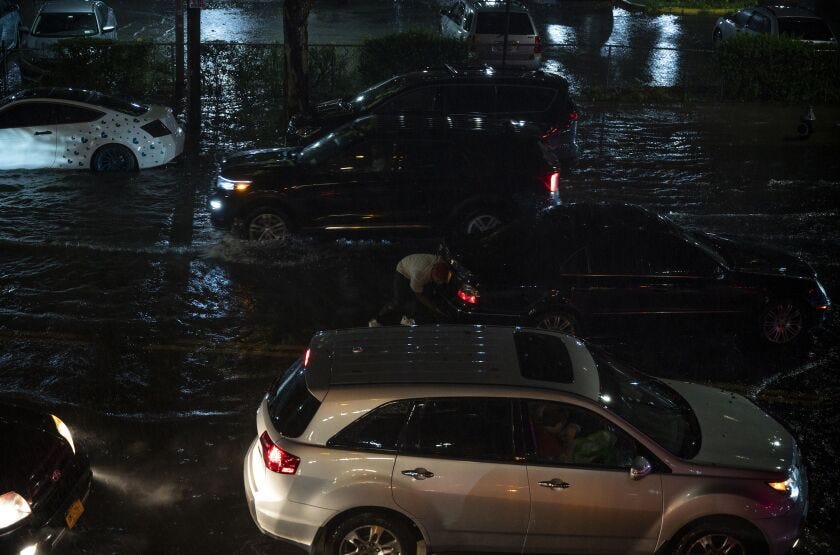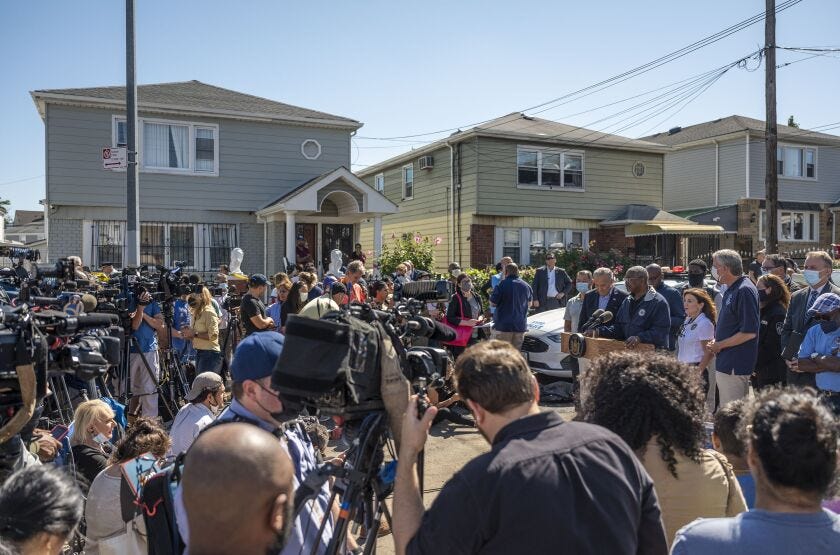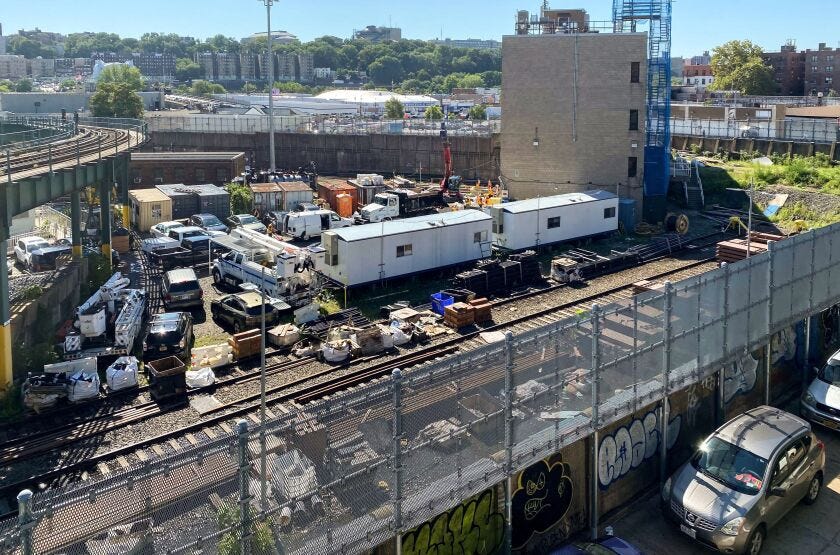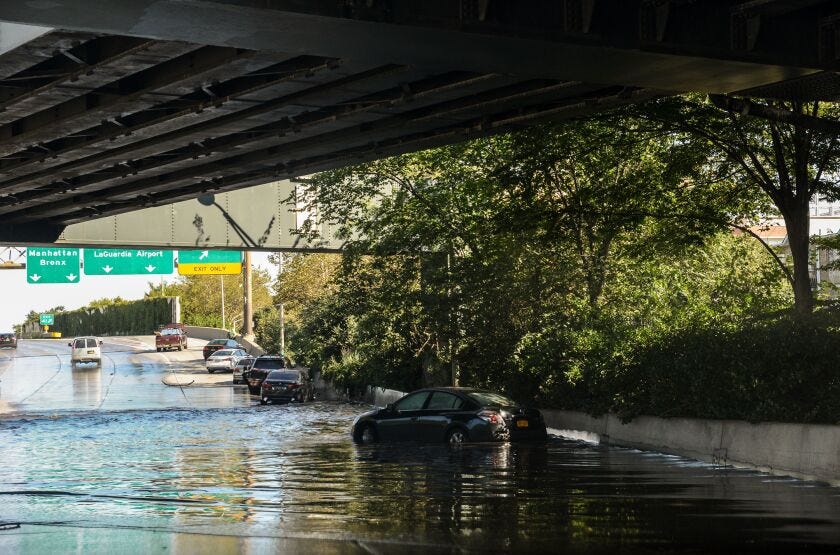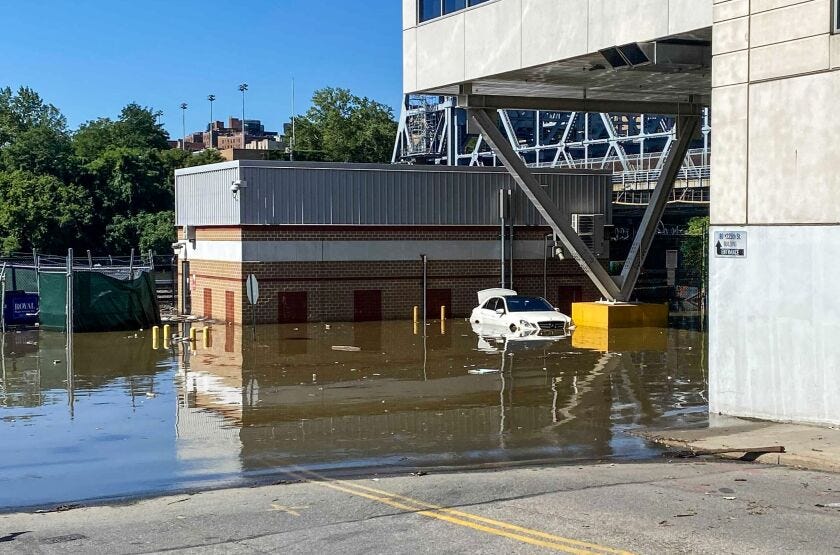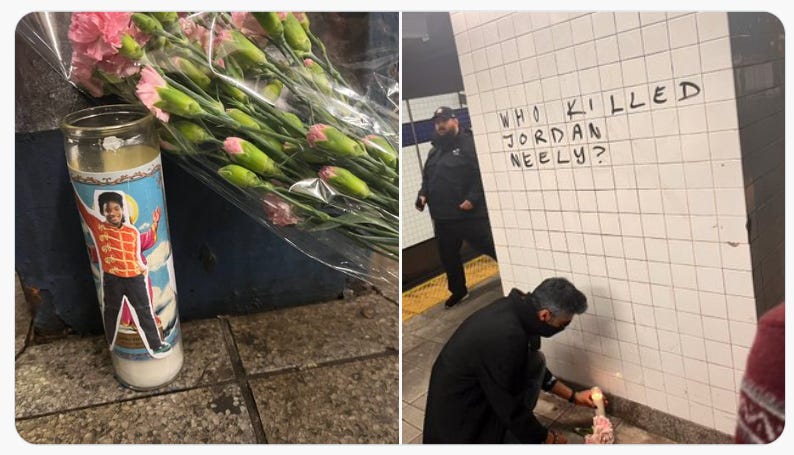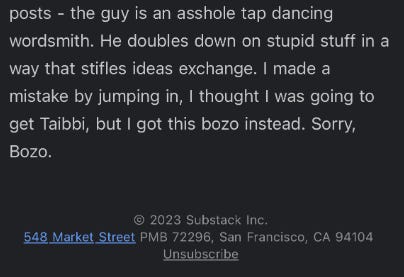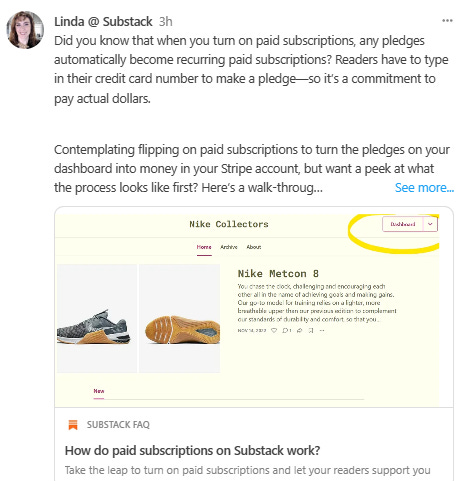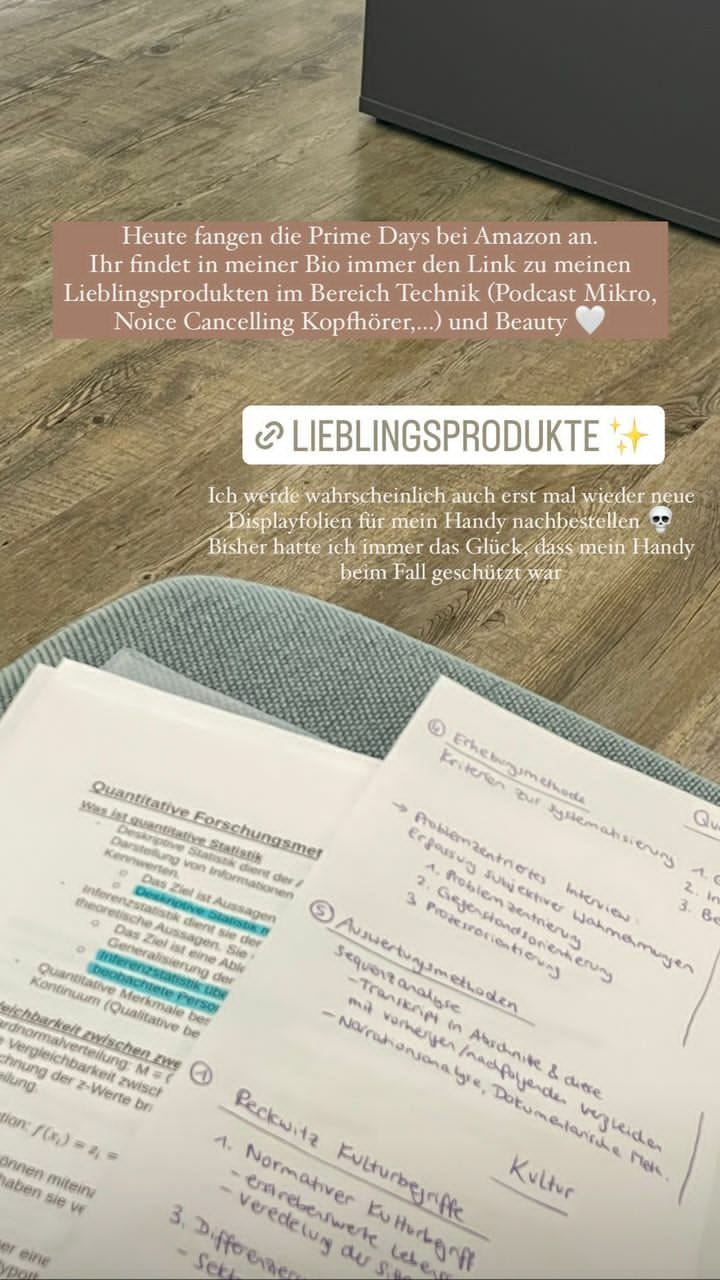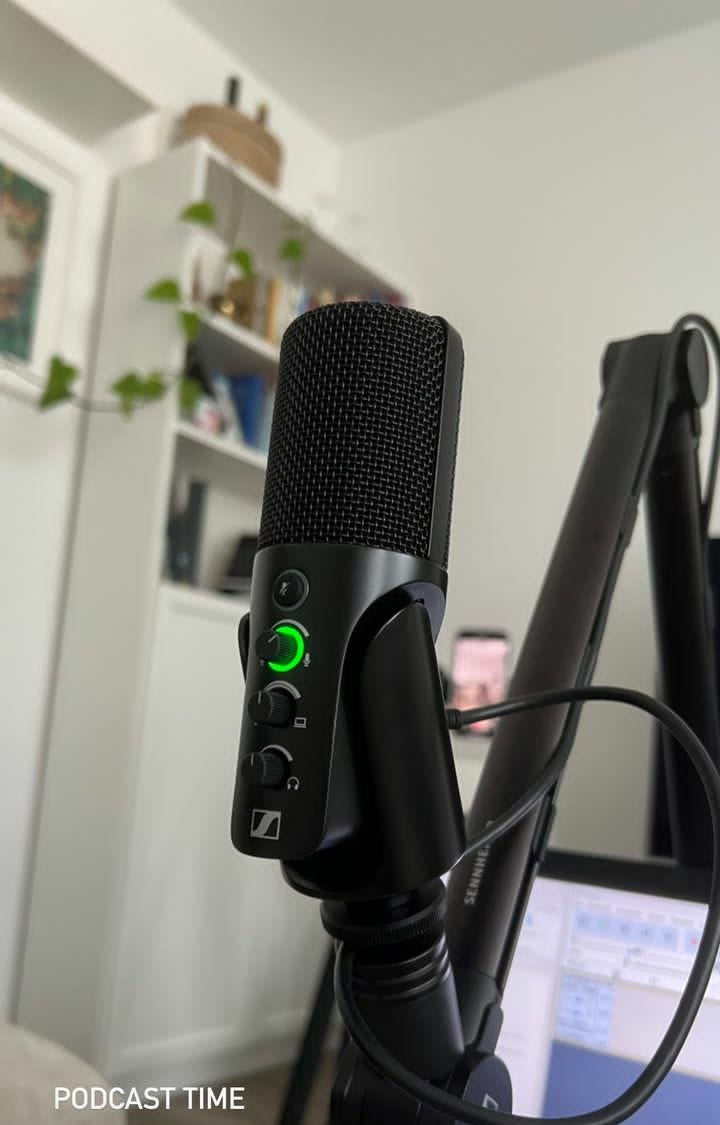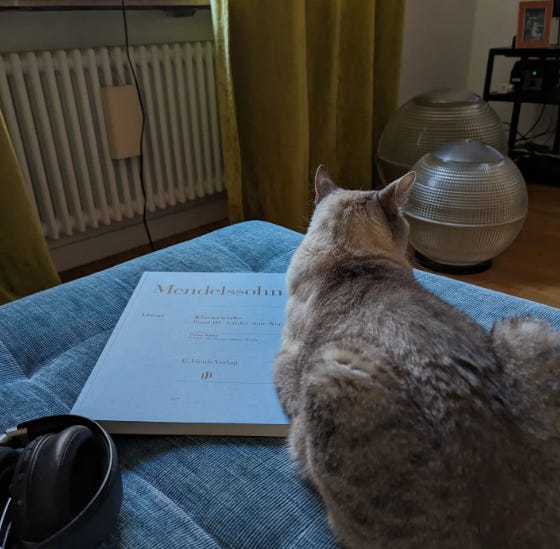NYC 2.54pm
NYC gives the police US$12 billion every year but isn't addressing our infrastructure, the climate crisis, or housing that's safe from floods.
The last time there was severe flooding like this in NYC (around last Christmas) Mayor Eric Leroy Adams was secretly in the Virgin Islands. Now is a good time to remember the mayor has been stripping away New York's landmark climate bill on behalf of his buds in real estate.
As climate change turns flooding into a more regular, deadly problem for New York City, Mayor Eric Leroy Adams has seemed more concerned about inundating the subway with cops whose main purpose seems to be the implicit threat of violence. Mayor Eric Leroy Adams and his admin was caught flat-footed during today's massive rainstorm and faced a deluge of criticism as schools, homes, subways, and roads flooded - but the mayor tipped his hypothetical hat to his team.
At a drop-in center for homeless youth, Mayor Eric Leroy Adams made a promise last year. By marshaling limited city resources and following a detailed blueprint, New York City would aim to eradicate homelessness among younger New Yorkers.
It was a bold goal, but one the mayor said was personal to him as someone who grew up on the brink of poverty and eviction.
But since Mr. Adams unveiled his plan, the administration has all but abandoned key elements of it. The charity that served as the host of his announcement went under, citing years of late payments from city government as a main reason. The mayor discontinued integral parts of the plan, leaving vacant a years-old City Hall position dedicated to tackling youth homelessness, and discontinuing the newly created “peer navigators” for homeless and runaway youth.
In his nearly two years as mayor, Mr. Adams has struggled to meet the city’s need for varied critical services, especially as other challenges arise. Some efforts, like ending youth homelessness, have suffered; other initiatives, like fighting crime and rats, have been more successful — helping fulfill the mayor’s campaign pledge to reduce visible signs of disorder.
Yet a comprehensive review of the Mayor’s Management Report, a 520-page compendium packed with statistics about the city’s performance during Mr. Adams’s tenure, shows that services elsewhere are sliding, and perhaps none more glaringly than those serving the city’s most disadvantaged residents.
Heavy rainfall and flash flooding are predictable emergencies, yet the City and State remain unprepared to protect New Yorkers--especially those living in basement apartments.
The unprecedented rainfall that remnants of Hurricane Ida dumped Wednesday night made New York City’s climate vulnerabilities starkly visible, less than two weeks after Tropical Storm Henri broke previous rain records.
Boulevards across boroughs could’ve been mistaken for rivers. Yankee Stadium became a lake. Waterfalls cascaded into subway stations.
The scenes were vastly different from those from the coastal flooding in 2012’s Superstorm Sandy, which prompted high-profile protection projects focused on waterfront areas vulnerable to storm surge and sea-level rise.
The recent deluges highlight how heavy rains have been largely left out of the equation, experts told THE CITY.
“We need to rainproof New York City,” said Amy Chester, managing director of Rebuild By Design, a federal effort launched by the U.S. Department of Housing and Urban Development after Sandy.
The flooding from Ida occurred because an overloaded, century-old drainage system was not built to accommodate that much water, city officials acknowledge.
“Rainfall rates were really extraordinary and far exceeded the capacity of the system,” city Department of Environmental Preservation Commissioner Vincent Sapienza said Thursday at a briefing with Mayor Bill de Blasio and Gov. Kathy Hochul in Hollis, Queens. “Anything over two inches an hour, we’re going to have trouble with.”
The National Weather Service measured more than three inches an hour at the storm’s peak. At least 13 people died — including 11 trapped in flooded basement apartments.
Environmental advocates are calling for the city to enhance how it handles stormwater by expanding green infrastructure to increase absorption and by updating the system of sewers and pipes. Federal funds could help, but even with resources available it would take years to expand the city’s drainage capacity to handle massive weather events such as Ida.
“We’ve done a good job of thinking a lot about water coming in from the edge, but we’ve done a less good job of thinking about water coming from the sky,” said Rob Freudenberg, vice president of the energy and environment program at the Regional Plan Association.
Ida’s downpour — more than 7 inches in all in many parts of the city — overwhelmed a sewer system already hard-pressed to handle run-of-the-mill heavy rain.
Much of the city’s network handles both waste and rain runoff in a single pipe. When rainfall exceeds the system’s capacity, starting at about a tenth of an inch of rain per hour, untreated sewage bypasses treatment plants and makes its way directly into city waterways.
Intensely concentrated rainfall adds the risk of flooding to the mix, when even the combined sewer system cannot keep up with the influx. Climate research commissioned by the city projected in 2015 that the number of days with rainfall of at least four inches would increase by as much as 67% by this decade compared to the period of 1971 to 2000.
“It’s hard to overstate on how many systemic levels this represents a clear and present danger,” said Eddie Bautista, executive director of the New York City Environmental Justice Alliance, noting that the largest combined sewer overflows are located in communities of color.
Flooding from Hurricane Ida drowned two people in the basement of this home in Hollis, Queens. Sept. 2, 2021.Hiram Alejandro Durán/ THE CITY
When it comes to storm drainage, he said, “We’re taking it for granted at our own peril.”
After Superstorm Sandy caused citywide devastation, the influx of federal dollars mainly went to projects to rebuild and shore up the coastline. Many of those projects are still not near completed. But preventing inundation by rain in vulnerable locations is just as important, climate watchers say.
As required under 2018 laws sponsored by then-Councilmember Costa Constantinides (D-Queens), the city Department of Environmental Protection in May released a stormwater resiliency plan, along with a map of areas likely to flood due to stormwater. Both were due in 2020 but were delayed because the COVID-induced budget crisis forced the work to pause, said Mitch Schwartz, a de Blasio spokesperson.
The plan lays out actions for the city to undertake over the next decade, from advance storm alerts for basement residents to including stormwater flood measures in the city’s climate resiliency design guidelines.
The very first item on the agenda: “Inform the public about flood vulnerability from extreme rain.”
Those warnings did not come from city officials in advance of Ida.
De Blasio on Friday said he would accelerate the timeline for implementing the stormwater plan’s measures and establish an Extreme Weather Response Task Force to develop response protocols. He asked New Yorkers to brace for the unexpected.
“This kind of radical change in weather is beyond the understanding, beyond the reach of our typical measuring tools,” de Blasio said. “Things are happening that our projections can’t track with accuracy or consistency, which means we have to assume the worst in a way we never had before.”
Planning had already been underway for years. De Blasio’s OneNYC climate and infrastructure strategies are evolutions of former Mayor Mike Bloomberg’s 2007 PlaNYC, which identified what the city would need to address flash floods and upgrade the drainage system.
Ted Timbers,a spokesperson for the Department of Environmental Protection, said the city “invests hundreds of millions of dollars annually to upgrade the entire city’s drainage system, inland and coastal.”
Separating combined sewers is in process in Gowanus, College Point and Canarsie, according to Timbers. Meanwhile, the city is investing nearly $2 billion through 2025 upgrading drainage systems in flood-plagued Southeast Queens to increase capacity and prevent inundation, as well as making headway in Staten Island, he added.
But the city has no comprehensive initiative in place or planned to expand drain capacity throughout the city to prevent flooding.
Since Ida, elected officials have been demanding more.
“We need a much more aggressive and comprehensive approach now, one that doesn’t just rely on more studies and private-sector incentives, but brings the resources, regulatory reform, implementation, and enforcement needed to make change at scale quickly,” City Councilmember and comptroller candidate Brad Lander (D-Brooklyn) said in a statement.
He referred to the stormwater resiliency plan as “utterly inadequate.”
Queens Borough President Donovan Richards said at Thursday’s Hollis news conference: “Queens needs to see much more infrastructure investment.”
“We cannot wait until tomorrow. We need it today,” he added. “These lives could have been saved if we had investment that we sorely needed a long time ago.”
Natural Absorption
A cheaper — and quicker — way to manage stormwater is through green infrastructure projects, which absorb and redirect water. These interventions include rain gardens, rain barrels, permeable playgrounds and green roofs — generally, practices that decrease impervious surfaces or divert stormwater from even entering the drainage system.
Those measures can minimize, but not fully eliminate, the effects of extreme weather, experts say.
“We need to think about a plan and an investment strategy that looks at reducing urban heat, stormwater based flooding and benefitting habitat and clean air all at once,” said Kate Boicourt, director of New York and New Jersey coasts and watersheds at the nonprofit Environmental Defense Fund. “A lot of that comes down to green infrastructure investments.”
Delivery workers in Astoria toiled in waist-deep water for less than minimum wage as the remnants of Hurricane Ida poured over the region on Sept. 1, 2021. | Obtained by THE CITY
1 of 11
The Lake in Central Park overflowed onto Bethesda Terrace. Sept. 2, 2021 | Jose Martinez/ THE CITY
2 of 11
Commuters at Delancey St - Essex St moments after most train lines were suspended on Wednesday night. | Hiram Alejandro Durán/ THE CITTY
3 of 11
Hurricane Ida flooded homes in Queens. | Hiram Alejandro Durán/ THE CITY
4 of 11
Subway tracks at Brooklyn’s Newkirk Avenue stations filled with water during Wednesday night’s flash flood. Sept. 1, 2021. | Obtained by THE CITY
5 of 11
A man pushes a car through a flooded street in Brooklyn. | Hiram Alejandro Durán/THE CITTY
6 of 11
City, state and federal officials hold a press conference on 183rd Street in Hollis, Queens, following the death of multiple neighbors in Wednesday night’s flooding. Sept 2, 2021. | Hiram Alejandro Durán/ THE CITY
7 of 11
The 207th Street train yard in Manhattan was flooded by Ida. Sept. 2, 2021. | Claudia Irizarry Aponte/ THE CITY
8 of 11
The Brooklyn Queens Expressway near the Northern Boulevard exit in Jackson Heights. Sept. 2, 2021, | Katie Honan/THE CITY
9 of 11
A flooded parking lot in Marble Hill. Sept. 2, 2021. | Claudia Irizarry Aponte/ THE CITY
10 of 11
Downed branches being cleared in Central Park. Sept. 2, 2021. | Jose Martinez/ THE CITY
In the recently released report, the city flagged numerous “critical indicators” to measure its agencies’ progress in areas of concern. Of the 65 indicators gauging progress at social services, slightly more than half had gotten worse, according to the report. Roughly a third showed improvement, and seven were stable.
For Mr. Adams, the challenges confronting the city have never been greater. More than three years after the coronavirus pandemic began, the city’s economy is still hampered by the work-from-home trend, and now the administration must deal with the financial implications of a migrant influx that shows no sign of abating — complicating efforts to improve the city’s delivery of certain social services.
Only 40 percent of applications for food stamps were processed within a month, the legally mandated time frame, compared with 60 percent the year before and 93 percent before the pandemic.
Though the city reduced the time it takes to fix more systemic heat outages, it has been taking longer to address individual emergency heating and hot water requests in public housing, home to roughly 400,000 New Yorkers. It is taking significantly longer to prepare vacant public housing apartments for new residents, even as homelessness soars.
In Mr. Adams’s first full fiscal year as mayor, his administration took more than twice as long to process rent-freeze requests from low-income seniors and disabled New Yorkers, a problem the city blamed partly on budget-related staffing shortages. Even police response times rose across the board.
Jonah Allon, a spokesman for Mr. Adams, said the mayor remains focused on helping low-income New Yorkers, and pointed to areas where the administration made gains.
In a statement, Mr. Allon said that the administration had “built the most supportive housing units in a single year in the city’s history, paired more foster youth with life coaches through the Fair Futures program, increased the number of families accessing childcare through vouchers by roughly 73 percent and so much more.”
“Weaving a robust social safety net is a core component of Mayor Adams’s ‘Working People’s Agenda’ for a more equitable city,” Mr. Allon added.
Indeed, the city moved more homeless households into new housing, and increased the number of summer jobs and internships available to young New Yorkers and the number of seats available in Summer Rising, a summer school and recreational program created during the pandemic.
Yet many vulnerable New Yorkers struggle each day because of gaps in city services.
Stephanie Johnson, a single mother of four, was at risk of losing her Brooklyn home after her landlord abruptly stopped receiving rental subsidies from the city. In the Bronx, Diana Cruz was facing eviction and did not have a lawyer to help her, even though a city law guarantees free legal assistance.
Diana Ramos was struggling to find her next meal after the city took weeks to approve her request for food stamps. When Ms. Ramos, 46, called the city’s Human Resources Administration for help, she waited on hold for hours to no avail. She ended up relying on food pantries and her father, who recently sent her $40 over PayPal to buy some basics.
Ms. Ramos, who was assisted by the Safety Net Project at the Urban Justice Center, said she was relieved when her food stamps arrived last week.
“You know that I qualify for food stamps — I have no income,” she said. “Why is this so hard?”
A confluence of factors has contributed to the recent decline in city services.
The mayor has forced city agencies to curb spending, over the objections of Democrats on the City Council, citing an uncertain economic outlook and new labor deals. He has warned that additional budget cuts and a hiring freeze might be necessary as the city struggles to pay for housing thousands of migrants arriving from the southern border. The proposed cuts of up to 15 percent over the next year would be much deeper than past cuts and could prove even more harmful to poor New Yorkers.
Policy differences between Mr. Adams and his predecessor, Bill de Blasio, have also led to cuts for some of the previous administration’s priorities, including prekindergarten for all 3-year-olds.
Even before the migrant crisis, a city worker staffing shortage had hollowed out agencies; with more than 26,000 vacant positions, the city has found it difficult to deliver some basic municipal services, especially in a timely manner. This summer, nearly 7 percent of full-time city government jobs were unfilled, compared with around 2.5 percent in 2020, 2019 and 2014, according to the Citizens Budget Commission.
Mr. Allon acknowledged that “the ongoing asylum seeker crisis” has had “significant impacts on our city’s budget and agency operations.”
Demand has surged for cash assistance in New York City, yet 6 percent of the jobs are unfilled at the city division responsible for dispensing public assistance — more than double citywide historic norms, according to data provided by the state comptroller’s office.
The city processed only 29 percent of applications for cash assistance on time, compared with 95 percent in 2019. The delays violate state and federal law, a federal judge in Manhattan recently ruled, and the city must figure out a path to compliance by early next year.
Phara Souffrant Forrest, a state assemblywoman from Brooklyn, called the delays “shocking and cruel beyond words.”
Some agencies have taken months to fill important positions — a situation that some critics believe is a strategy by the Adams administration to lower costs.
Interviews with 13 current city staffers suggest that while the situation has improved this year at some agencies, others are still short-staffed, and triage remains the norm.
Last summer, city officials wrote a letter to the mayor’s office warning that low staffing levels were threatening critical services. The city budget office took 17 months to approve the hiring of an essential staff member, which prompted the director overseeing that position and members of the team to resign in protest.
The 11-page letter listed dozens of examples where services were endangered or harmed: A health center in Harlem delayed a distribution of cribs and car seats to families that is part of an effort to reduce infant mortality; there were fewer lead inspections at homes with newborns where other building units had documented lead paint hazards; a program that provides free eye exams to kindergartners and first-grade students reached 15 percent of eligible students, compared with 95 percent in the 2019-20 school year.
The staffing shortage also affected the city’s highly respected sexual health clinics and tuberculosis clinics. They have not fully reopened since closing at the height of the pandemic, even as sexually transmitted infections are rising and there are growing concerns about tuberculosis.
The city’s eight sexual health clinics saw nearly 95,000 annual visits before the pandemic; that number has dropped to nearly 62,000 over the last year, according to data from the Health Department. Only five of the clinics offered sexual health services, and a sixth reopened in July.
As for tuberculosis — a highly infectious disease that has higher rates in some other countries from which people emigrate to New York — one of the city’s four clinics, in Washington Heights, closed as part of the pandemic response and has not reopened.
Dr. Jay Varma, who served as a top health adviser to Mr. de Blasio, called on the city to reopen all the clinics. “They’re really a true safety net facility,” he said.
The declines in service are not limited to those for struggling New Yorkers. A lifeguard shortage prompted pool closings this summer. The Department of Cultural Affairs, which supports cultural institutions across the city, is responding to only 28 percent of customer service emails within two weeks, less than last year, and down from 91 percent in 2019.
New York City installed fewer protected bike lanes and fewer bus lanes than the year before, and the city appears to be on track to install fewer than legally required this calendar year. The number of street trees pruned fell to 46,000, roughly the same as last year and compared with nearly 71,000 in 2019.
“There are a lot of nuts and bolts that seem to be loosening,” said Andrew Rein, president of the Citizens Budget Commission.
With the migrant crisis overwhelming the city’s shelter system, the threat of homelessness is particularly troubling.
Ms. Cruz, 43, who lives in the Bronx and has nine children, is fighting eviction in housing court, but has not been able to secure a lawyer through the city’s right to counsel law. The law provides free access to lawyers for tenants in eviction cases, but there are not enough lawyers available.
Ms. Cruz’s circumstances are hardly unique: As eviction cases have risen sharply, 63 percent of tenants facing eviction had legal representation during a three-month period last year — down from 71 percent during the same period in 2021, according to the city’s Office of Civil Justice.
“This is my first eviction,” Ms. Cruz said. “I’ve always paid my rent. I don’t know what to do. I don’t know where to start.”
A year ago, Lyndon Chris Hernandez, a 26-year-old formerly homeless man who has emerged as a leader in the world of homeless and runaway youth, appeared with Mr. Adams at the unveiling of the mayor’s plan to end youth homelessness. Mr. Hernandez got a job as a privately funded peer navigator for runaway and homeless youth, but saw his colleagues who were hired with city money lose their jobs.
Judge dismisses Uber, DoorDash and Grubhub's challenge of NYC min pay rate law for app-based food delivery workers -- but sides with Relay, which is not a consumer-facing delivery platform.
In August, over breakfast at a diner in Queens, he said he was not all that surprised by the administration’s actions. “The mayor makes empty promises,” he said.
=========END————
Thank you, as always, for reading. If you have anything like a spark file, or master thought list (spark file sounds so much cooler), let me know how you use it in the comments below. Thank you so much for letting me vent! If you enjoyed this article, you can give pledge to me (click PLEDGE button) or simply share this article with a friend. It helps me more than you realise.
If you enjoyed this post, please share it.
______________
Professor Hendrik, Professor Eric, and another person, Prof David A. Andelman, former Bureau Chief NYTimes recommended my substack, also some Chief Technology of Financial Times (FT) recommended my substack, not only subscribe. I'd be happy to get more & more PLEDGE and recommendations for better crafted writing (via Bank Central Asia (with my full-name ADI MULIA PRADANA, clearing code 0140119, account number 0201558866 or via STRIPE. For me, prefer Bank Central Asia).
If a friend sent this to you, you could subscribe here 👇. All content is free, and paid subscriptions are voluntary.
——————————————————————————————————
-prada- Adi Mulia Pradana is a Helper. Former adviser (President Indonesia) Jokowi for mapping 2-times election. I used to get paid to catch all these blunders—now I do it for free. Trying to work out what's going on, what happens next. Now figure out and or prevent catastrophic of everything.
(Very rare compliment and initiative pledge, and hopefully more readers more pledges to me. Thank you. My note-live blog about Russia - Ukraine already click-read 6 millions, not counting another note especially Live Update Substack (mostly Live Update Election or massive incident)
=======
Thanks for reading Prada’s Newsletter. I was lured, inspired by someone writer, his post in LinkedIn months ago, “Currently after a routine daily writing newsletter in the last 10 years, my subscriber reaches 100,000. Maybe one of my subscribers is your boss.” After I get followed / subscribed by (literally) prominent AI and prominent Chief Product and Technology of mammoth global media (both: Sir, thank you so much), I try crafting more / better writing.
To get the ones who really appreciate your writing, and now prominent people appreciate my writing, priceless feeling. Prada ungated/no paywall every notes-but thank you for anyone open initiative pledge to me.
(Promoting to more engage in Substack) Seamless to listen to your favorite podcasts on Substack. You can buy a better headset to listen to a podcast here (GST DE352306207).
Listeners on Apple Podcasts, Spotify, Overcast, or Pocket Casts simultaneously. podcasting can transform more of a conversation. Invite listeners to weigh in on episodes directly with you and with each other through discussion threads. At Substack, the process is to build with writers. Podcasts are an amazing feature of the Substack. I wish it had a feature to read the words we have written down without us having to do the speaking. Thanks for reading Prada’s Newsletter.
Wants comfy jogging pants / jogginghose amid scorching summer or (one day) harsh winter like black jogginghose or khaki/beige jogginghose like this? click
Headset and Mic can buy in here, but not including this cat, laptop, and couch / sofa




